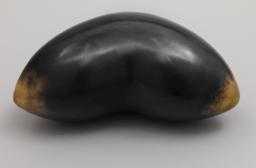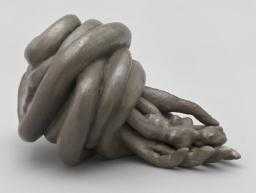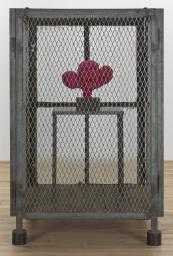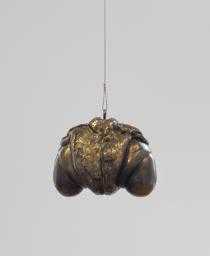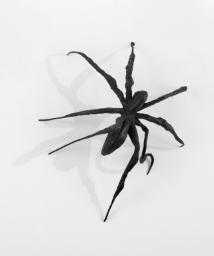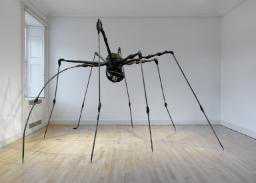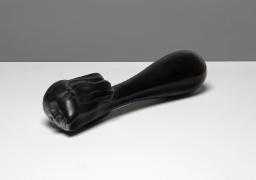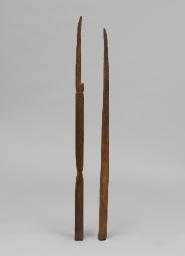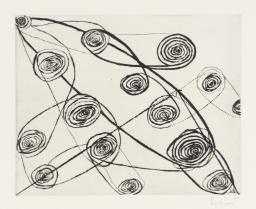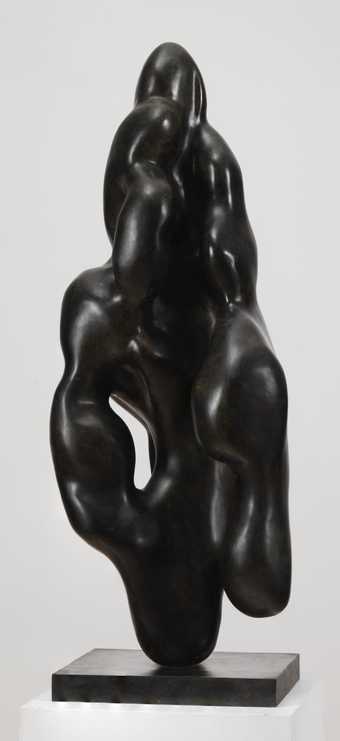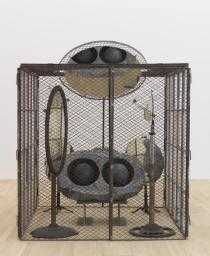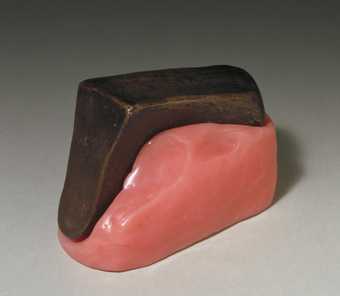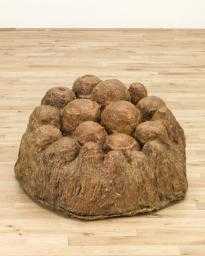
Not on display
- Artist
- Louise Bourgeois 1911–2010
- Medium
- Bronze
- Dimensions
- Object: 916 × 694 × 300
weight:approx. 75kg (124kg cased) - Collection
- Tate
- Acquisition
- Presented by the artist 2001
- Reference
- T07780
Summary
An amoeba is a single-celled organism which moves by changing its shape and reproduces by division. Bourgeois's sculpture Amoeba is a roughly modelled organic form, its bulges and single opening suggesting a moving, living creature in the stages of evolution. The idea for it came from the artist's memories of the tadpoles she played with in one of the rivers near her various homes as a child (Weiermair, p.15). It is dominated by a large swelling which evokes pregnancy and pre-natal life. Herself a mother, Bourgeois has made pregnancy and motherhood the subject of many works. She made several drawings in the 1940s and 1950s depicting the maternal body, swollen with breasts or eggs. She has said: 'for me, sculpture is the body. My body is my sculpture' (Bourgeois, p.228). She has also written: 'our own body could be considered, from a topographical point-of-view, a land with mounds and valleys and caves and holes. So it seems rather evident to me that our own body is a figuration that appears in mother earth' (Bourgeois, p.126). Amoeba was originally made of plaster which, now cast in bronze with a white patina, it still resembles. The bronze casting took place in 1984. This is the first in an edition of six. Uncharacteristically for a Bourgeois sculpture, Amoeba is mounted on the wall. In this it is related to another sculpture, Torso, Self-Portrait 1963-4 (Galerie Lelong, Zurich), which is made of the same materials and is usually hung in a similar way. This connection with Torso suggests that Amoeba can be read as a portrait of the artist as a protean organism coming into being.
The early 1960s were a period of intense sculptural experimentation for Bourgeois who, after using mainly wood in the 1940s and 1950s, turned to such non-traditional materials as latex, plastic, rubber and cement as well as the classic sculptural materials of plaster, bronze and marble. Her early sculptures were hard, vertical, totemic forms, often made by mounting wooden elements on a pole supported by a metal base. Generically known as her Personnages (1947-9), they represent people (those she loved, those she missed) and were exhibited standing in meaningful relation to one another. They were followed by more geometric wooden structures in the 1950s. With the new materials Bourgeois began modelling softer, more organic forms which lie on a horizontal surface, or hang freely in space from a hook. Several of these are titled Lair, indicating a desire to hide or a need to make a home. Others are referred to as Landscapes and represent instincts and urges from the unconscious. These works expand the sculptural language for the emotional and psychological world which Bourgeois had begun with the wooden Personnages.
Further reading:
Louise Bourgeois: Memory and Architecture, exhibition catalogue, Museo Nacional Centro de Arte Reina Sofia, Madrid 1999, reproduced pl.32
Louise Bourgeois, Marie-Louise Bernadac, Hans-Ulrich Obrist, Destruction of the Father/Reconstruction of the Father: Writings and Interviews 1923-1997, London 1998
Peter Weiermair, Louise Bourgeois, exhibition catalogue, Frankfurter Kunstverein, Frankfurt am Main 1995, p.15, reproduced p.94, pl.47
Elizabeth Manchester
August 2001
Does this text contain inaccurate information or language that you feel we should improve or change? We would like to hear from you.
Display caption
The idea for Amoeba came from the artist’s memories of the tadpoles she played with in
a river near her childhood home. The roughly-modelled organic form of the sculpture resembles a living creature, and the large swelling may be an allusion to pregnancy. Herself a mother, Bourgeois has made many works that explore themes of pregnancy and motherhood. ‘For me, sculpture is the body’, she has said. ‘My body is my sculpture’.
Gallery label, November 2005
Does this text contain inaccurate information or language that you feel we should improve or change? We would like to hear from you.
Explore
- abstraction(8,615)
-
- non-representational(6,161)
-
- irregular forms(2,007)
- monochromatic(722)
- birth to death(1,472)
-
- pregnancy(45)
You might like
-
Louise Bourgeois Tits
1967 -
Louise Bourgeois Nature Study
1986 -
Louise Bourgeois Cell XIV (Portrait)
2000 -
Louise Bourgeois Janus Fleuri
1968 -
Louise Bourgeois Spider I
1995 -
Louise Bourgeois Spider
1994 -
Louise Bourgeois Fallen Woman
1981 -
Louise Bourgeois Untitled
1946–7 -
Louise Bourgeois KNIFE COUPLE
1949 -
Louise Bourgeois Untitled (Safety Pins)
1991 -
François Stahly Growth
1963 -
Louise Bourgeois Cell (Eyes and Mirrors)
1989–93 -
Marcel Duchamp Wedge of Chastity
1954, cast 1963 -
Louise Bourgeois Avenza
1968–9, cast 1992 -
Louise Bourgeois Mamelles
1991, cast 2001

